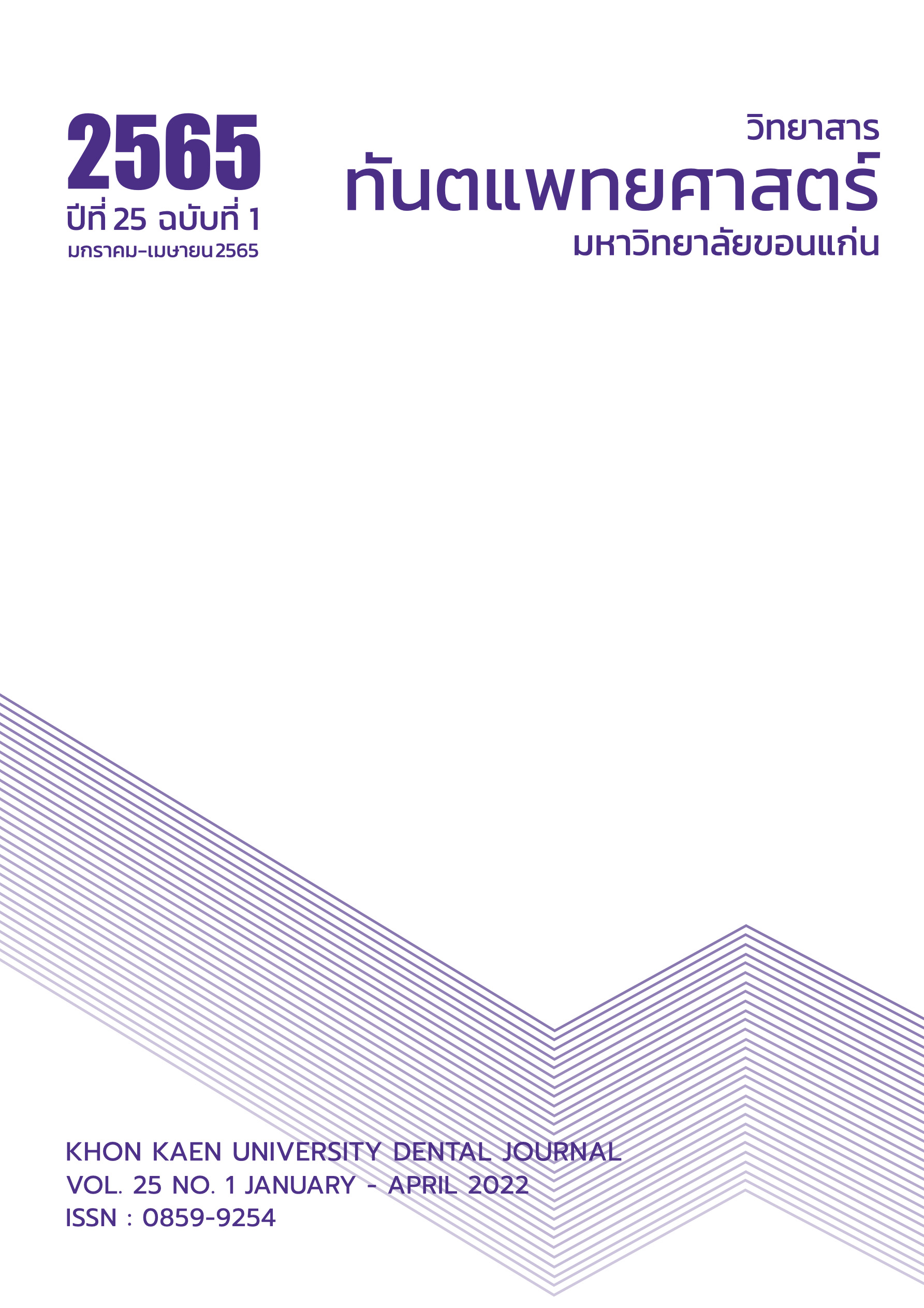Classification of Gingival Phenotype in A Group of Thais by Cluster Analysis
Main Article Content
Abstract
The purpose of this study was to classify various forms of gingival phenotype based on the dimensions of maxillary central incisors and the surrounding gingival tissues in a sample of 100 periodontally healthy Thais (mean age 24.33±3.14 years). Four clinical variables were used in hierarchical cluster analysis: crown width/crown length ratio (CW/CL), gingival width (GW), papilla height (PH) and gingival thickness (GT) score. The latter was assessed by periodontal probe visibility through the sulcus wall. Three clusters with specific features were identified. Cluster 1 (34 males, 37 females) displayed a slender tooth form (CW/CL = 0.71), a GW of 4.92 mm, a PH of 4.40 mm, and a thin gingiva (Probe visible on one or both incisors) in 66.2% of the subjects. These parameters were significant difference from cluster 3 (7 males, 3 females) which displayed a quadratic tooth form (CW/CL = 0.84), a GW of 7.50 mm, a PH of 3.37 mm, and a thick gingiva (Probe concealed on both incisors) in 80.0% of the subjects. Cluster 2 (9 males, 10 females) presented mixed features between cluster 1 and cluster 3. These subjects showed a quadratic tooth form (CW/CL = 0.83), a narrow zone of gingival (GW = 4.61 mm), low papillae (PH = 3.53 mm) and thin gingiva in 73.7 % of the subjects. In conclusion, this analysis demonstrated two extreme gingival phenotypes, a narrow, thin and highly scalloped gingiva with slender teeth on the one hand (the most prevalent group, 71% of the subjects) and a wide, thick and flat scalloped gingiva with quadratic teeth on the other (10% of the subjects). For the remaining group (19% of the subjects), it was recognized with a narrow, thin, but flat gingiva and quadratic teeth.
Article Details

This work is licensed under a Creative Commons Attribution-NonCommercial-NoDerivatives 4.0 International License.
บทความ ข้อมูล เนื้อหา รูปภาพ ฯลฯ ที่ได้รับการลงตีพิมพ์ในวิทยาสารทันตแพทยศาสตร์ มหาวิทยาลัยขอนแก่นถือเป็นลิขสิทธิ์เฉพาะของคณะทันตแพทยศาสตร์ มหาวิทยาลัยขอนแก่น หากบุคคลหรือหน่วยงานใดต้องการนำทั้งหมดหรือส่วนหนึ่งส่วนใดไปเผยแพร่ต่อหรือเพื่อกระทำการใด ๆ จะต้องได้รับอนุญาตเป็นลายลักษณ์อักษร จากคณะทันตแพทยศาสตร์ มหาวิทยาลัยขอนแก่นก่อนเท่านั้น
References
Kan JY, Morimoto T, Rungcharassaeng K, Roe P, Smith DH. Gingival biotype assessment in the esthetic zone: visual versus direct measurement. Int J Periodontics Restorative Dent 2010;30(3):237-43.
Kao RT, Pasquinelli K. Thick vs thin gingival tissue: a key determinant in tissue response to disease and restorative treatment. J Calif Dent Assoc 2008; 30(7): 521-6.
Cook DR, Mealey BL, Verrett RG, Mills MP, Noujeim ME, Lasho DJ, et al. Relationship between clinical periodontal biotype and labial plate thickness: an in vivo study. Int J Periodontics Restorative Dent 2011; 31(4):345-54.
Zweers J, Thomas RZ, Slot DE, Weisgold AS, Van der Weijden FG. Characteristics of periodontal biotype, its dimensions, associations and prevalence: a systematic review. J Clin Periodontol 2014;41(10):958-71.
Müller HP, Eger T. Gingival phenotypes in young male adults. J Clin Periodontol 1997;24(1):65-71.
Müller HP, Heinecke A, Schaller N, Eger T. Masticatory mucosa in subjects with different periodontal phenotypes. J Clin Periodontol 2000;27(9):621-6.
Müller HP, Eger T. Masticatory mucosa and periodontal phenotype: a review. Int J Periodontics Restorative Dent 2002;22(2):172-83.
Jepsen S, Caton JG, Albandar JM, Bissada NF, Bouchard P, Cortellini P, et al. Periodontal manifestations of systemic diseases and developmental and acquired conditions: Consensus report of workgroup 3 of the 2017 WorldWorkshop on the Classification of Periodontal and Peri-Implant Diseases and Conditions. J Periodontol 2018;89 (Suppl 1):S237–48.
Ochsenbein C, Ross S. A reevaluation of osseous surgery. Dent Clin North Am 1969;13(1):87-102.
Seibert JL, Lindhe J. Esthetics and periodontal therapy. In: Lindhe J, editor. Textbook of clinical periodontology. 2nd ed. Copenhagen: Munksgaard;1989.477-514.
Schuger S, Yuodelis R, Page RC, Johnson RH. Periodontal disease, 2nd ed. Philadelphia: Lea & Febiger;1990.506-9.
Fu JH, Lee A, Wang HL. Influence of tissue biotype on implant esthetics. Int J Oral Maxillofac Implants 2011; 26(3):499-508.
Romeo E, Lops D, Rossi A, Storelli S, Rozza R, Chiapasco M. Surgical and prosthetic management of interproximal region with single-implant restorations: 1-year prospective study. J Periodontol 2008;79(6): 1048-55.
Evans CD, Chen ST. Esthetic outcomes of immediate implant placements. Clin Oral Implants Res 2008; 19(1):73-80.
De Rouck T, Eghbali R, Collys K, De Bruyn H, Cosyn J. The gingival biotype revisited-transparency of the periodontal probe through the gingival margin as a method to discriminate thin from thick gingiva. J Clin Periodontol 2009;36(5):428-33.
Cuny-Houchmand M, Renaudin S, Leroul M, Planche L, Guehennec L, Soueidan A. Gingival biotype: the probe test utility. Open Journal of Stomatology. 2013;3(2):123-7. [cited 2021 Jan 20]. Available from https://www.scirp.org/journal/paperinformation.aspx?paperid=31266
Benjapupattananan S, Sirikururat P. Relationship between smile line, gingival biotype, tooth shape, and gingival zenith of maxillary central incisiors in a group of Thai young adults. M Dent J 2019;39(2):4552.
Sutthiboonyapan P, Arsathong K, Phuensuriya J, Fuengfu J, Wang H-L, Kungsadalpipob K. Characteristics of gingival biotype of maxillary incisors in thai young Adults. J Dent Assoc Thai 2019;69(3): 303-11.
Daniel WW, Cross CL. Biostatistics: A foundation for analysis in the health sciences. 10th ed. New York: John Wiley & Sons; 2013.191-3.
Olsson M, Lindhe J, Marinello CP. On the relationship between crown form and clinical features in gingiva of adolescents. J Clin Periodontol 1993;20(8):570-7.
Olsson M, Lindhe J. Periodontal characteristics in individuals with varying form of the upper central incisors. J Clin Periodontol 1991;18(1):78-82.
Müller HP, Schaller N, Eger T, Heinecke A. Thickness of masticatory mucosa. J Clin Periodontol 2000;27(6):431-6.
Vandana KL, Savitha B. Thickness of gingiva in association with age, gender and dental arch location. J Clin Periodontol 2005;32(7):828-30.
Muller HP, Kononen E. Variance components of gingival thickness. J Periodontal Res 2005;40(3):239–44.
Kungsadalpipob K, Jamsakorn K, Pumnil S, Sutthiboonyapan P. Analysis of maxillary incisor tooth dimensions and gingival phenotype in thai young adults. J Dent Assoc Thai 2020;70(3):209-15.


